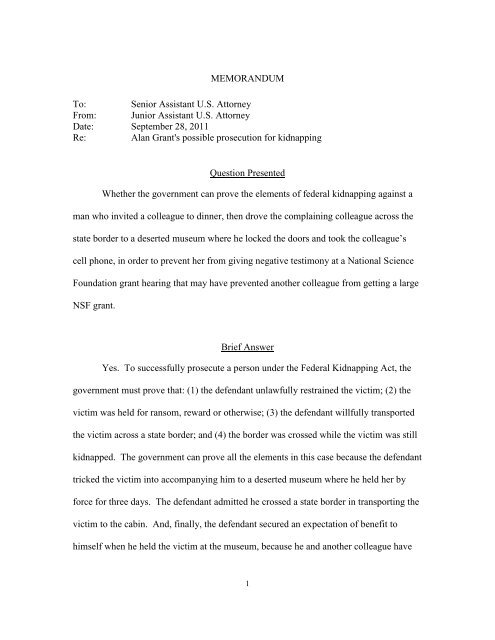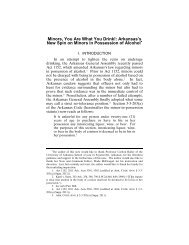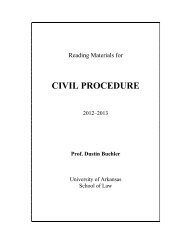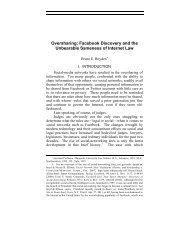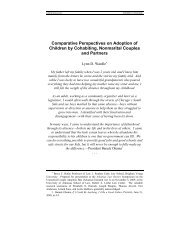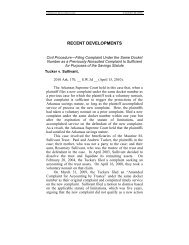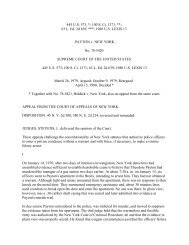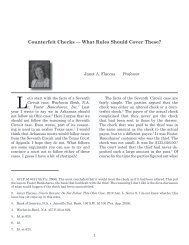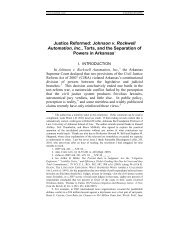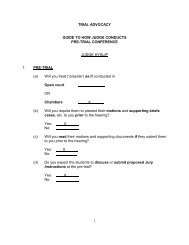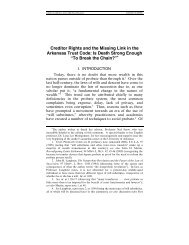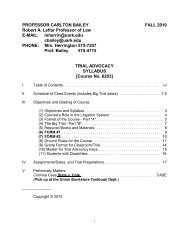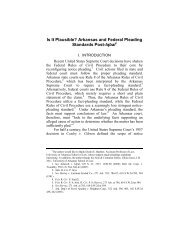Sample Memo Formatted
Sample Memo Formatted
Sample Memo Formatted
Create successful ePaper yourself
Turn your PDF publications into a flip-book with our unique Google optimized e-Paper software.
MEMORANDUM<br />
To: Senior Assistant U.S. Attorney<br />
From: Junior Assistant U.S. Attorney<br />
Date: September 28, 2011<br />
Re: Alan Grant's possible prosecution for kidnapping<br />
Question Presented<br />
Whether the government can prove the elements of federal kidnapping against a<br />
man who invited a colleague to dinner, then drove the complaining colleague across the<br />
state border to a deserted museum where he locked the doors and took the colleague’s<br />
cell phone, in order to prevent her from giving negative testimony at a National Science<br />
Foundation grant hearing that may have prevented another colleague from getting a large<br />
NSF grant.<br />
Brief Answer<br />
Yes. To successfully prosecute a person under the Federal Kidnapping Act, the<br />
government must prove that: (1) the defendant unlawfully restrained the victim; (2) the<br />
victim was held for ransom, reward or otherwise; (3) the defendant willfully transported<br />
the victim across a state border; and (4) the border was crossed while the victim was still<br />
kidnapped. The government can prove all the elements in this case because the defendant<br />
tricked the victim into accompanying him to a deserted museum where he held her by<br />
force for three days. The defendant admitted he crossed a state border in transporting the<br />
victim to the cabin. And, finally, the defendant secured an expectation of benefit to<br />
himself when he held the victim at the museum, because he and another colleague have<br />
1
helped each other in the past, and the circumstances of the kidnapping suggest the act was<br />
done to once again support the colleague in furtherance of the mutually beneficial<br />
relationship.<br />
Statement of Facts<br />
This memo analyzes whether the government will be able to prove all elements of<br />
federal kidnapping against thirty nine-year-old Dr. Alan Grant.<br />
Prior to the alleged kidnapping, both Grant and the alleged victim, Dr. Mary<br />
Schweitzer, were invited to Helena, Montana, to attend a meeting on Monday, June 20,<br />
2011, designed to prepare Dr. Jack Horner for a hearing to take place on Wednesday,<br />
June 22, on his grant proposal at the National Science Foundation. Grant Stmt. p. 1;<br />
Schweitzer Stmt. p. 5. Dr. Jack Horner is a paleontologist and the director of the<br />
Museum of the Rockies located in Bozeman, Montana. Grant Stmt. p. 1.<br />
Upon arriving at the meeting on Monday, June 20, Schweitzer stated that she had<br />
made a discovery that cast serious doubts on the viability of Horner’s proposal.<br />
Schweitzer Stmt. p. 5; Grant Stmt. p. 2. Grant stated that Horner “did not want<br />
[Schweitzer] appearing before the NSF panel” and that he had asked Grant to “talk some<br />
sense into her.” Grant Stmt. p. 2. Later that day, Grant invited Schweitzer to an early<br />
dinner, to which she agreed. Grant Stmt. p. 2; Schweitzer Stmt. p. 5. They went to<br />
dinner, and when they got back into Grant’s truck, Grant announced that they were going<br />
to the Museum of the Rockies in Bozeman. Grant Stmt. p. 2. Grant said the trip was<br />
necessary for Schweitzer to “better understand the implications of [her] planned<br />
2
testimony before the NSF.” Schweitzer Stmt. p. 5. Schweitzer said she told Grant that<br />
she “didn’t want to go there” but he “acted like he didn’t hear [her].” Id. Schweitzer said<br />
she “repeatedly told him to turn around and take [her] back to Helena so [she] could<br />
gather [her] things and catch [her] flight. [But] he just wouldn’t listen to [her].” Id.<br />
Grant admitted that Schweitzer said she didn’t want to go to the museum, but he “kept<br />
driving and she kept complaining.” Grant Stmt. p. 3. Grant said he “tuned her out.” Id.<br />
During the trip to the museum, Grant stated that a major accident on I-90<br />
involving semi-trailer trucks caused him to take a detour onto I-15, which runs toward<br />
Idaho. Grant Stmt. p. 3. They traveled into Idaho before they could catch a direct road<br />
back into Montana and to the museum. Id.<br />
When they arrived at the museum, Schweitzer got out of Grant’s truck and<br />
attempted to walk back to the main road. Id. Grant “directed her into the museum by<br />
holding her arm.” Id. Once inside, Grant “flipped a switch to bolt down the fire doors”<br />
and he “took her cell phone.” Schweitzer Stmt. p. 6. Schweitzer tried to yell to get<br />
someone’s attention. Id. No one else was at the museum, however, because Dr. Horner<br />
always closes the museum during that particular week in June. Grant Stmt. p. 3. Grant<br />
and Schweitzer stayed at the museum from Monday evening until Thursday morning. Id.<br />
Grant maintains that he did not kidnap Schweitzer. Grant Stmt. p. 4. He said they<br />
were comfortable at the museum and that they were “colleagues having an important<br />
discussion about career-changing matters.” Id. Grant further stated that he was prompted<br />
to take these actions because he and Dr. Horner are “good friends” and he “wanted to do<br />
3
[Horner] a favor.” Id. Grant stated that Horner had “done a lot for my career in the past.<br />
You know, one hand washes the other.” Id.<br />
Applicable Statute<br />
Federal Kidnapping Statute<br />
18 U.S.C. § 1201(a)(1) (2006)<br />
(a) Whoever unlawfully seizes, confines, inveigles, decoys, kidnaps, abducts, or<br />
carries away and holds for ransom or reward or otherwise any person, except in<br />
the case of a minor by the parent thereof, when<br />
(1) starts at .5 all at 1(1)the person is willfully transported in interstate or<br />
foreign commerce, regardless of whether the person was alive when<br />
transported across a state boundary, or the offender travels in interstate or<br />
foreign commerce or uses the mail or any means, facility, or<br />
instrumentality of interstate or foreign commerce in committing or in<br />
furtherance of the commission of the offense;<br />
. . .<br />
shall be punished by imprisonment for any term of years or for life and, if the<br />
death of any person results, shall be punished by death or life imprisonment.<br />
Discussion<br />
The government will be able to prove a charge of federal kidnapping against Alan<br />
Grant. The statute requires the government to prove that the defendant “unlawfully<br />
seize[d], confine[d], inveigle[d], decoy[ed], kidnap[ped], abduct[ed], or carr[ied] away<br />
and [held] for ransom or reward or otherwise [the victim] . . . when . . . the [victim was]<br />
willfully transported in interstate or foreign commerce . . . .” 18 U.S.C. § 1201(a)(1)<br />
(2006). The Ninth Circuit sets out the elements of the crime as follows: (1) the defendant<br />
unlawfully restrained the victim; (2) the victim was held for ransom, reward or otherwise;<br />
(3) the defendant willfully transported the victim across a state border; and (4) the border<br />
4
was crossed while the victim was still kidnapped. United States v. Bancalari, 110 F.3d<br />
1425, 1428 (9th Cir. 1997). The government will be able to show that Grant’s conduct<br />
satisfies the elements of the crime because Grant tricked Schweitzer into joining him on a<br />
trip that included taking the objecting Schweitzer across state lines to a deserted museum<br />
where Schweitzer was locked in the building without access to her cell phone for three<br />
nights. Further, Grant held Schweitzer in order to prevent her from providing negative<br />
testimony at an NIH grant hearing on a grant application submitted by Grant’s colleague,<br />
Dr. Jack Horner. To the extent that the government must prove that Grant acted in order<br />
to receive a benefit to himself, the government can prove that Grant had an expectation of<br />
future benefit in the form of career assistance or continued friendship with Horner.<br />
1. Unlawful Seizure and Restraint<br />
The government can prove that Grant unlawfully seized and restrained<br />
Schweitzer. The Federal Kidnapping Act requires the defendant to “unlawfully seize[],<br />
confine[], inveigle[], decoy[], abduct[], or carr[y] away and hold[]” the victim. 18 U.S.C.<br />
§ 1201(a) (2006). The “involuntariness of the seizure and detention . . . is the very<br />
essence of the crime of kidnapping.” Chatwin v. United States, 326 U.S. 455, 464<br />
(1946). The act of kidnapping requires “an unlawful physical or mental restraint against<br />
a person’s will.” Id. at 460. Unlawful restraint may be found when the victim initially<br />
consents to accompany the eventual captor, but then either withdraws consent or is held<br />
by force. United States v. Wesson, 779 F.32 1443, 1444 (9th Cir. 1986); United States v.<br />
Redmond, 803 F.2d 438, 439 (9th Cir. 1986).<br />
5
For example, in Chatwin, the Court found no unlawful restraint when a young<br />
woman left the custody of juvenile authorities and traveled to Mexico, where she married<br />
the defendant. 326 U.S. at 460. The Court reasoned that “[n]othing indicate[d] that she<br />
was deprived of her liberty, compelled to remain where she did not wish to remain, or<br />
compelled to go where she did not wish to go.” Id. However, in Wesson, the court held<br />
that a young woman was unlawfully restrained when she initially consented to<br />
accompany the defendant on a long haul trip, but withdrew her consent when he began to<br />
physically abuse her during the trip. 779 F.2d at 1444. The court stated that “although<br />
she initially agreed, [the young woman] testified that she later wanted to go home and<br />
told the defendant of her desires.” Id. The court reasoned that “[n]either the victim nor<br />
her parents consented to the kind of trip eventually undertaken.” Id. Likewise, the court<br />
held in Redmond that the victim had been unlawfully restrained when she had been<br />
tricked into taking a ride with the defendant through the promise of an ice cream cone,<br />
and then confined by force by the defendant. 803 F.2d at 439. The court reasoned that<br />
“[t]he fact that one originally accompanies another without being forced does not prevent<br />
the occurrence of a kidnapping where force is later used to seize or confine the victim.”<br />
Id.<br />
In our case, Schweitzer was not free to come and go like the young girl in<br />
Chatwin. To the contrary, she was deprived of her liberty, compelled to remain where<br />
she did not wish to remain, and compelled to go where she did not wish to go. Grant<br />
admits that he took Schweitzer to the museum despite her protests. He further admits<br />
that, once they arrived at the museum and Schweitzer attempted to walk back to the main<br />
6
oad, he “took [Schweitzer’s] arm and made her start back to the cabin.” Moreover,<br />
escape from the museum became impossible when “Grant flipped a switch to bolt down<br />
the fire doors” and “took her cell phone.” Schweitzer tried to get someone’s attention at<br />
the museum, but “realized that was futile when no staff members arrived for work” the<br />
next day. Thus, Schweitzer was unlawfully restrained by Grant.<br />
Although Schweitzer initially agreed to accompany Grant to dinner, this consent<br />
is of no significance. Unlawful restraint began when Grant told Schweitzer that they<br />
were going to the museum and Schweitzer responded by telling Grant that she “didn’t<br />
want to go [there].” Like the young woman in Wesson who was unlawfully seized,<br />
Schweitzer originally consented to accompany Grant for one purpose, dinner; she did not<br />
consent “to the kind of trip eventually undertaken.” Furthermore, the fact that Schweitzer<br />
was not initially seized by force does not prevent a finding of unlawful restraint. Like the<br />
promise of ice cream in Redmond that lured the girl into the defendant’s car, Grant used<br />
the promise of dinner to lure Schweitzer into Grant’s truck and his eventual control. The<br />
fact that she was held by force thereafter is sufficient to prove unlawful restraint.<br />
Because Schweitzer was held against her wishes after the dinner, the government can<br />
prove that Grant unlawfully restrained her.<br />
2. Held for Ransom, Reward or Otherwise<br />
The government can prove that Grant held Schweitzer for ransom, reward or<br />
otherwise. To prosecute a federal kidnapping charge successfully, the government must<br />
7
establish that the defendant held the victim “for ransom or reward or otherwise.” 18<br />
U.S.C. § 1201(a)(1).<br />
The terms “ransom” and “reward” are not limited in meaning to “benefits of<br />
pecuniary value.” Gooch v. United States, 297 U.S. 124, 126 (1936). Rather, “reward”<br />
implies something given in return for good or evil done or received.” Id. The word<br />
“otherwise” broadens the reach of the Kidnapping Act by extending it to those defendants<br />
who kidnap and hold victims not only for reward, but “for any other reason”. Id. at 127<br />
(citing S. Rep. No. 534, 73rd Cong., 2d Sess., Mar. 20, 1934; H.R. Rep. No. 1457, 73rd<br />
Cong., 2d Sess., May 3, 1934, pg. 2). Therefore, an expectation of benefit to the<br />
transgressor that is not pecuniary and does not fall within the commonly understood<br />
meaning of “reward,” falls within the broad term “otherwise.” Gooch, 297 U.S. at 129.<br />
However, because “kidnapping is undesirable in itself, without regard to its<br />
purpose,” the Court subsequently held that an illegal purpose need not be shown. Gawne<br />
v. United States, 409 F.2d 1399, 1403 (9th Cir. 1969) (citing United States v. Healy, 376<br />
U.S. 75 (1964)). The legislative wording of the statute “suggests no distinction based on<br />
the ultimate purpose of a kidnapping.” Id. Instead, the focus is on the term “hold,” since<br />
“involuntariness of seizure and detention . . . is the very essence of the crime of<br />
kidnapping.” Id. at 1403 (citing Chatwin v. United States, 326 U.S. 455, 464 (1946)).<br />
Consequently, “the true elements of the offense are an unlawful seizure and holding,<br />
followed by interstate transportation,” rather than the defendant’s motive. Id.<br />
Several circuits accept this theory that “the kidnaper’s [sic] motivation is not an<br />
element of the offense.” Gawne, 409 F.2d at 1403 (internal citations omitted). Some<br />
8
courts reached this conclusion prior to the 1964 decision in Healey through their own<br />
interpretation of Gooch; others, like the Ninth Circuit, arrived at this conclusion by way<br />
of the Healy holding. Id. Regardless, at least one circuit still interprets Gooch as<br />
requiring proof of purpose. Id. (citing United States v. Varner, 283 F.2d 900 (7th Cir.<br />
1960)).<br />
In Gooch, the Court held that the defendants secured a benefit to themselves when<br />
they captured two law enforcement officers in order to avoid their own capture and arrest.<br />
Gooch, 297 U.S. at 128. The Court reasoned that kidnapping for money and kidnapping<br />
for freedom from arrest are “similar in their general nature,” and that if “the word<br />
‘reward,’ as commonly understood, is not itself broad enough to include benefits<br />
expected to follow the prevention of an arrest, they fall within the broad term<br />
‘otherwise.’” Id.<br />
In this case, because Grant will be prosecuted in the Ninth Circuit, his reason for<br />
keeping Schweitzer from testifying against his friend Jack Horner’s proposal at the NSF<br />
grant hearing is a non-issue to his successful prosecution. Therefore, no proof of that<br />
reason will be required under the Healy-Gawne line of cases.<br />
However, Grant will likely defend himself by invoking the Gooch rule requiring<br />
proof of motive, asserting the position that he did not receive a direct benefit from taking<br />
Schweitzer to the museum. This defense is not sustainable. Grant’s actions fell within<br />
the broad language of the statute when he held Schweitzer at the museum to prevent her<br />
from testifying at the NSF grant hearing, just as the defendants did in Gooch when they<br />
held the law enforcement officers to keep themselves from being arrested.<br />
9
Grant may still argue that his actions do not fall within the purview of the statute<br />
because, unlike the defendants in Gooch who held the officers “with the expectation of<br />
benefit” to themselves, Grant did not hold Schweitzer with an expectation of benefit to<br />
himself. Rather, he did so for the exclusive benefit to Dr. Horner, whose NSF grant<br />
would be in jeopardy if Schweitzer appeared before the grant committee. This argument<br />
fails for two reasons. First, Grant did receive a benefit from his actions, in that he<br />
acknowledged his actions were conducted either as payment for Horner’s past assistance<br />
or with an expectation of future benefit from Horner. Grant stated that Horner had asked<br />
him “if [Grant] could do him a favor.” Acknowledging that Horner had “done a lot for<br />
[Grant’s] career in the past,” Grant “wanted to do [Horner] a favor,” adding, “You know,<br />
one hand washes the other.” Secondly, and more importantly, this argument fails because<br />
the captor’s purpose or motivation for the kidnapping is irrelevant. Kidnapping a person<br />
for “any reason” is sufficient. Thus, the government can prove that Grant “held<br />
[Schweitzer] for ransom, reward or otherwise.”<br />
3. Willful Transportation Across A State Border<br />
The government will be able to prove that Grant willfully transported Schweitzer<br />
across a state border. The Federal Kidnapping Act requires that the defendant “willfully<br />
transport [the victim] in interstate or foreign commerce . . . .” 18 U.S.C. § 1201(a)(1)<br />
(2006). Willful transportation exists when the defendant transports the victim from one<br />
point to another and, in so doing, crosses a state line. United States v. Napier, 518 F.2d<br />
316, 319 (9th Cir. 1975). Neither the defendant’s knowledge nor his intention of crossing<br />
10
state lines is relevant. Id. (citing Bibbins v. United States, 400 F.2d 544 (9th Cir. 1968)).<br />
The requirement that the offender cross state lines merely furnishes a basis for the<br />
exercise of federal jurisdiction and does not constitute an element of the offense. Id.<br />
In Napier, the court held that the jurisdictional element had been satisfied when<br />
the defendant transported his victim from Oregon to Washington. Id. The defendant<br />
argued on appeal that the trial court’s jury instructions were erroneous because<br />
knowledge of crossing state lines was an essential element of the kidnapping offense. Id.<br />
The court rejected the argument and held that knowledge of a border crossing is not an<br />
essential element of the kidnapping offense. Id.<br />
Here, Grant admitted he took Schweitzer across the state line from Montana into<br />
Idaho: “We traveled into Idaho before I could catch a direct road back into Montana and<br />
up to the museum.” Like the defendant in Napier who willfully transported his victim<br />
from Oregon to Washington, Grant willfully transported Schweitzer when he took her<br />
from Montana into Idaho.<br />
Although Grant did not intend to take the road into Idaho, he did so, and the mere<br />
occurrence is what matters since this element merely provides the jurisdictional predicate<br />
for federal jurisdiction. Thus, the government will be able to prove that Grant willfully<br />
transported Schweitzer across state lines.<br />
4. While so Kidnapped<br />
The government can prove that Schweitzer’s kidnapping was still in progress at<br />
the time Grant drove across the border. Under the Federal Kidnapping Act, the victim<br />
11
must be “willfully transported in interstate or foreign commerce . . . in furtherance of the<br />
commission of the offense.” 18 U.S.C. § 1201. The act of kidnapping requires the<br />
government to prove that the defendant “willfully transported the victim across a border<br />
in interstate or foreign commerce while so kidnapped.” Bancalari, 110 F.3d at 1428.<br />
Sufficient evidence exists to find a kidnapping was ongoing when the victim did not give<br />
voluntarily consent by the time the border was crossed, and when she was held<br />
involuntarily after the border was crossed. Id. at 1429.<br />
In Bancalari, the court held that the unlawful kidnapping of the victim continued<br />
at the time the border was crossed. There, the defendant forced the victim and her<br />
daughter into his truck by gunpoint, drove to the Mexican border, and threatened to use a<br />
gun on the victim if she did not keep quiet. Id. at 1428. The court rejected the<br />
defendant’s argument that the victim consented to crossing the border with him because<br />
she did not want to leave her child. Id. The court found no evidence that the victim had<br />
consented to accompany the defendant across the border, and found strong evidence that<br />
the kidnapping continued even after the border was crossed. Id. at 1429.<br />
Similarly, the evidence in this case is void of evidence of any consent by<br />
Schweitzer to accompany Grant after they had left the restaurant, and specifically, when<br />
Grant drove them across the Montana-Idaho border. Grant stated, “[Schweitzer] said she<br />
didn’t want to go the museum . . . . [But he] kept driving and she kept complaining.”<br />
Also, like the facts in Bancalari, where the victim was held by force after the border was<br />
crossed, the evidence is strong that Schweitzer continued to be held against her will after<br />
she and Dr. Grant crossed into Idaho and then back into Montana. Once Grant stopped<br />
12
his truck at the museum, Schweitzer attempted to walk back to the main road, but<br />
“[Grant] directed her back into the museum by holding her arm.” Moreover,<br />
Schweitzer’s statement indicates that Grant locked the doors to the museum and<br />
confiscated her cell phone.<br />
Although it is unclear whether Schweitzer complained to Grant at the moment the<br />
border was crossed, the absence of evidence implying she consented to the trip prior to<br />
crossing the border, as well as the ample evidence suggesting she was held by force at the<br />
museum, are sufficient to prove the kidnapping had not terminated at the time the border<br />
was crossed. Consequently, the government will be able to prove Grant transported<br />
Schweitzer across state lines while she was kidnapped.<br />
Conclusion and Recommendations<br />
The law is clear in its application to these facts. Based on the analysis above, the<br />
government should be able to prove Dr. Grant kidnapped Dr. Schweitzer under the<br />
Federal Kidnapping Act, 18 U.S.C. § 1201(a)(1) (2006).<br />
13


